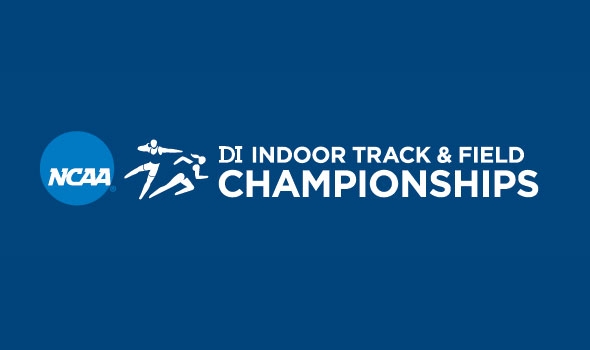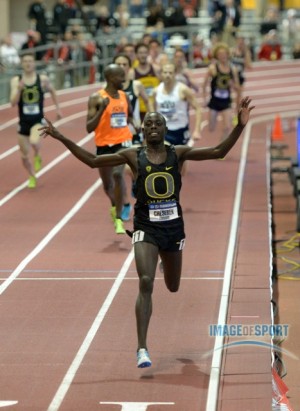Observations on the Men’s NCAA Indoors Entries: Oregon vs. Florida in team race + What does it take to get in?
By LetsRun.com
March 4, 2015
Last night, the NCAA announced the list of qualifiers to the 2015 NCAA Division I Indoor Track & Field Championships, to be held March 13-14 at the University of Arkansas. We’ve looked over the men’ entries and have a few thoughts. *Women’s entries
Men’s competition
Scored track meets can be hard to follow, but we’ve done our best to give you a starting point by scoring the meet based on the entry lists. To create the chart below, we simply looked at the entries and assigned points to the top eight seeds according to the 10-8-6-5-4-3-2-1 scoring system used at NCAAs. In the event of a tie, we split the points as the NCAA would (eg. if two athletes tied for seventh, each would earn 1.5 points). We’ve listed the top four men’s teams below.
| Event | Oregon | Florida | Arkansas | Texas A&M |
| 60 | ||||
| 200 | 10 | |||
| 400 | 11 | 14 | ||
| 800 | 10 | |||
| Mile | 11 | |||
| 3000 | 26 | 8 | ||
| 5000 | 17 | 3 | ||
| 60 hurdles | 10 | |||
| 4×400 | 8 | 1 | 10 | |
| DMR | 10 | 4 | ||
| HJ | ||||
| PV | 8 | |||
| LJ | 10 | 10 | ||
| TJ | 10 | 6 | ||
| SP | 8 | |||
| WT | ||||
| Heptathlon | ||||
| TOTAL | 64 | 60 | 41 | 40 |
Here are the events in which each school has an athlete(s) entered but not projected to score:
Oregon: weight throw (#9)
Florida: 200 (#16), 400 (#9, #14), triple jump (#12)
Arkansas: 400 (#16), 5000 (#12), triple jump (#14)
Texas A&M: 200 (#14), pole vault (#11)
- The projected scores suggest that the team race will be a battle between distance-heavy Oregon and a well-rounded Florida squad. The way track and field operates as a team event is weird, though. The only event in which the Ducks and Gators both have athletes entered is the 5k. So apart from that event, Oregon and Florida will be competing against the rest of the NCAA only to be scored against each other at the end of the meet. It’s kind of like if the New England Patriots and San Antonio Spurs played the Super Bowl and NBA Finals against different teams but were scored against each other at the end.
-
Oregon used 47 points in the distances to defeat Florida at outdoor NCAAs last year, 88-70. The Ducks will be even more dependent on the distance events — and stud Edward Cheserek, who is entered in the mile and 3k and expected to anchor the DMR — this time around, as all 64 of their projected points are from the distance events. Oregon has three entrants in mile, five (!!!) in 3k, three in 5k and a DMR squad. Apart from that, UO has just one athlete at the meet: Greg Skipper, seeded ninth in the weight throw. Compare that to Florida, who has athletes in the 200, 400, 800, 5000, long jump, triple jump, shot put along with a 4×400 squad.
- Arkansas’ duo of Stanley Kebenei and Kemoy Campbell are going to be very important if anyone else is to win the meet. If Kebenei (#7 seed in 3k) and Campbell (#3 in 3k, #12 in 5k) can manage to outperform expectations and finish ahead of some Oregon athletes in the 3k and 5k, they’ll improve their own team’s chances while simultaneously lowering Oregon’s. If the Razorbacks — or anyone else — is going to pull the upset, they’ll need some help in the distance events. Kebenei and Campbell could provide that help.
- Texas A&M’s Bowerman winner Deon Lendore didn’t finish his 400 prelim at SECs last weekend. If he winds up a medical scratch at NCAAs, A&M’s points in the 400 and 4×400 figure to drop and any chance of an NCAA title evaporates.
- Oregon was only sixth at NCAA XC last fall but with the additions of Will Geoghegan, Johnny Gregorek and Parker Stinson (none of whom were on the Ducks’ XC roster), UO is projected to dominate the distance events at NCAAs. Champion Colorado is sending a total of four guys (Jake Hurysz and Morgan Pearson are double-entered in the mile/3k and 3k/5k, respectively), though last year’s third-placer in the 3k, Ben Saarel is not among them. Conversely, NCAA XC runner-up Stanford only qualified one distance runner to the meet (Erik Olson in the 3k — and he wasn’t even on their cross country roster!) plus a DMR squad, though it should be noted top runners Maksim Korolev and Joe Rosa didn’t compete indoors. Third-place Portland didn’t qualify a single guy to the meet in any event; Ryan Poland was their highest guy on the descending order list, ranking 37th in the 3000.
- Georgetown had three guys run under 3:59 in the mile, but only one of them will run that distance at NCAAs. Ahmed Bile was the last guy in at 3:58.54. Teammate Amos Bartelsmeyer was seeded ahead of him (3:58.45) but chose not to enter the mile (Georgetown will likely put him on the DMR). The third sub-3:59 Hoya, Ryan Manahan (3:58.57) will run the 800 instead.
- What does it take to get to NCAAs? We’ve run through the last five editions of the championships and posted the time of the final qualifier in each of the men’s distance events below. In the final column, we’ve put the qualifying standards for the 2015 USATF Indoor Championships for comparison (clearly the 5000 mark — used this year for entry into the 2-mile — is a bit aggressive as only six people in the world have broken 13:30 indoors in 2015).
| Event | 2011 | 2012 | 2013 | 2014 | 2015 | 2015 USA indoors |
| 800 | 1:48.08 | 1:48.56 | 1:48.65 | 1:48.84 | 1:48.28 | 1:49.50 |
| Mile | 3:59.03 | 3:59.08 | 3:59.39 | 3:59.23 | 3:58.54 | 3:59.50 |
| 3000 | 7:54.42 | 7:52.92 | 7:53.74 | 7:53.53 | 7:53.27 | 8:00.00 |
| 5000 | 13:49.05 | 13:50.03 | 13:45.61 | 13:49.78 | 13:48.34 | 13:30.00 |
| DMR | 9:33.77 | 9:31.71 | 9:31.23 | 9:31.82 | 9:32.36 | N/A |




